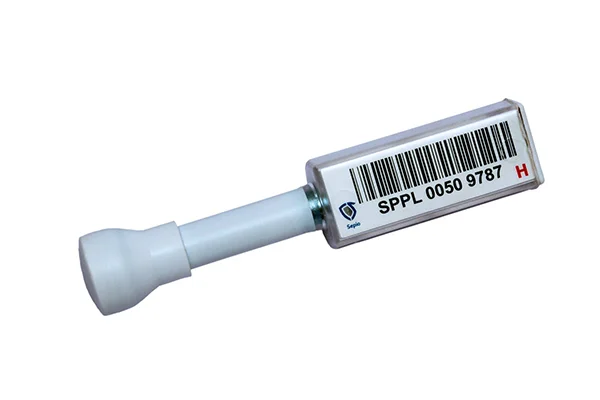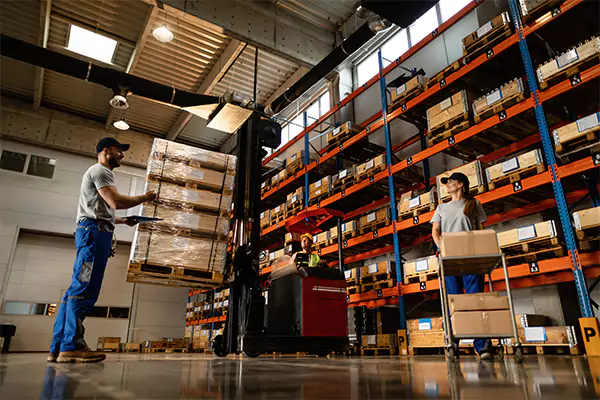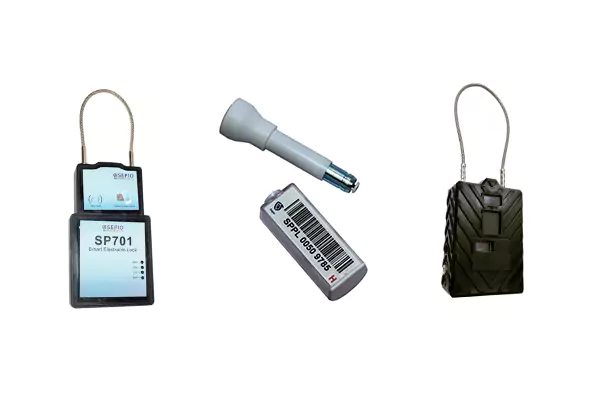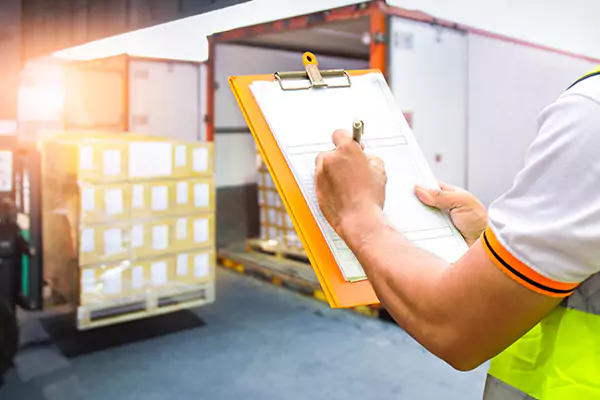Secure RFID E-Seal
Protecting Containers from Unauthorized Access and Speeding Up Port Clearance
Applications of RFID E Seal

Exports

Imports

Logistics

High value cargo
About Secure RFID E-Seal
Secure RFID E-Seal is an advanced, tamper-evident electronic seal designed specifically for shipping containers and high-value cargo in global supply chains. Engineered to prevent unauthorized access, streamline customs clearance, and improve traceability, it combines physical sealing strength with smart RFID-based tracking.
Unlike conventional container seals, which only offer visible tamper protection, Secure RFID E-Seal enables wireless identification, digital traceability, and rapid scanning — helping logistics teams, customs authorities, and shipping partners work more efficiently and securely.
Built with a rugged bolt body and embedded RFID chip, each seal carries a unique identifier that can be read using RFID readers or NFC-enabled devices without physical contact, even when the seal is affixed to a locked container. This ensures faster clearance at ports and greater control across checkpoints.
How RFID Helps:
- Captures scan data, helping you know when and where a container seal was scanned — adding a verifiable digital trail to your supply chain.
- Improves supply chain visibility by linking seal IDs with shipment, location, or container-specific data – ensuring accurate tracking from origin to destination.
- Speeds up port and customs clearance by enabling quick, contactless authentication — no manual inspection or paperwork delays.
Secure RFID E-Seal is ideal for sealing shipping containers in cross-border transport, especially for high-value goods, regulatory-sensitive shipments, and export-bound cargo. By combining physical tamper evidence with digital verification, it strengthens security while reducing bottlenecks across customs and logistics operations.


Where Can You Use Secure RFID E-Seal?
Secure RFID E-Seal is trusted across industries where physical protection, tamper evidence, and digital traceability are critical. Designed for global container shipments, it combines a strong bolt seal with RFID-enabled identification – helping improve security, speed up customs clearance, and enable better tracking across the supply chain.
-
Transport & Logistics
Ideal for containers, trailers, tankers, and closed-body vehicles – RFID E-Seals enable fast scanning and help monitor seal status throughout transit for better route-level visibility and control.
-
Customs Clearance
RFID E-Seals simplify inspection and clearance processes by allowing customs officers to quickly read seal information without breaking or removing the seal – improving turnaround time and reducing manual errors.
-
Freight Forwarding
Used by freight handlers and consolidators to maintain shipment integrity across multiple destinations, RFID scanning makes it easy to verify seal status and match cargo to manifests digitally.
-
Retail & Consumer Goods Supply Chain
Supports secure, traceable movement of goods from factory to shelf – allowing faster scanning at distribution hubs and reducing delays in warehouse and inventory operations.
-
Pharmaceutical & Healthcare
Secures vaccine containers, medical supply boxes, and cold chain packaging – RFID allows quick verification and status tracking without compromising the integrity of temperature-sensitive cargo.
-
Mining & Energy Sectors
Protects cargo in remote or high-risk transit routes – RFID visibility helps monitor the security of valuable equipment or raw material containers across long distances.
-
Third-Party Logistics (3PL) & Warehousing
Enables streamlined seal tracking during inbound and outbound operations – helping logistics teams maintain seal integrity and improve digital recordkeeping at warehouse gates.
Why Choose Secure RFID E-Seal?
-
Real-Time Visibility
RFID technology allows instant access to seal data – helping you monitor container status, seal authenticity, and shipment movement throughout the supply chain in real-time.
-
Improved Supply Chain Security
Each RFID E-Seal is embedded with a unique ID that cannot be duplicated, enabling secure, tamper-evident sealing and faster detection of unauthorized access attempts.
-
Operational Efficiency
RFID readers can scan multiple seals simultaneously without line-of-sight, dramatically reducing the time spent on inspections, manual entry, and paperwork during cargo handling.
-
Regulatory Compliance
Secure RFID E-Seals help meet customs and international shipping regulations by maintaining digital records of seal status, location, and access logs, supporting smoother audits and inspections.
-
Cost Savings
By reducing manual checks, speeding up port operations, and minimizing cargo delays or theft, RFID E-Seals deliver a cost-effective sealing and tracking solution for high-value and cross-border shipments.

Various Type of RFID E-Seals
-
Active RFID E-Seals
Equipped with an internal battery, these seals actively transmit data and enable real-time location tracking – ideal for long-distance monitoring in high-value or time-sensitive shipments.
-
Passive RFID E-Seals
Relying on external RFID readers for activation, these battery-free seals are cost-effective and suitable for environments where scanning is done at checkpoints or during port clearance.
-
Semi-Passive RFID E-Seals
These seals use a battery to power internal sensors (like temperature or motion), but data transmission only occurs near an RFID reader—making them ideal for sensitive goods like pharmaceuticals or perishables.
-
Tamper-Evident RFID E-Seals
These seals combine physical tamper indicators with RFID-based alerts to detect and record unauthorized access, offering dual-layer security for high-risk cargo and cross-border transit.

Things to Consider While Buying a RFID E-seal
-
Frequency Compatibility
Ensure the RFID E-Seal operates on the same frequency as your existing RFID readers for seamless integration and consistent performance.
-
Reading Distance
Choose a seal with a suitable reading range based on how close or far your scanning infrastructure will be—this affects scanning speed and accuracy at checkpoints.
-
Battery Life
For battery-powered seals, verify the battery life is sufficient to last the full shipment duration, especially for long-haul or international cargo.
-
Security Features
Look for features like tamper evidence, unique IDs, and encrypted data to match your required level of cargo protection and compliance standards.
-
Durability
Select seals made from robust materials that can withstand vibrations, impact, temperature fluctuations, and rough handling during transit.
-
System Compatibility
Ensure the RFID E-Seal works with your existing RFID infrastructure (software, handhelds, fixed readers, etc.) to avoid expensive upgrades.
-
Cost Effectiveness
Balance performance and price – opt for seals that offer reliable RFID tracking, enhanced security, and durability without exceeding your budget.

How to Install Secure RFID E-Seal
Installing Secure RFID E-Seals involves both physical sealing and RFID setup. Begin by choosing the right RFID E-Seal for your cargo or container. Attach the RFID seal securely to the locking point—typically the latch or bolt area of a container door—ensuring a firm and tamper-evident closure.
Next, use RFID encoding software to assign a unique ID to each seal. This step is critical for enabling traceability and accurate tracking. Ensure your RFID readers and software are correctly configured to detect and store the seal data during scanning.
Before full-scale deployment, conduct a few test installations to verify seal readability, scanning distance, and data capture accuracy across different checkpoints. This helps prevent errors in live operations and ensures seamless cargo movement, especially through customs and high-security areas.
For smooth implementation and system integration, consider working with an experienced RFID solutions provider.

Best Practices
Before scaling up with RFID E-Seals, ensure the system aligns with your operational goals and works seamlessly across your logistics network:
- Define Objectives – Be clear on what you want to achieve: better security, faster clearance, or enhanced inventory tracking.
- Evaluate Infrastructure – Check if your existing RFID setup supports the seal’s frequency range, reading distance, and software requirements.
- Test Rigorously – Pilot test the RFID E-Seals across multiple cargo types and checkpoints to ensure consistent performance and data capture.
- Plan Implementation – Create a clear roadmap for integrating RFID tracking into your supply chain operations, including training and process updates.
- Maintain the System – Regularly monitor reader accuracy, seal performance, and software compatibility to avoid breakdowns or data loss.
- Secure Your Data – Implement robust cybersecurity practices to protect sensitive shipment and tracking data captured by RFID systems.
FAQ's
A traditional container seal is a physical lock on a container door to prevent unauthorized access. On the other hand, RFID technology uses radio waves to communicate between an RFID reader and an RFID tag on the container. The tag contains information about the container, such as its origin, destination, and contents. RFID tags can be read at a distance, and multiple tags can be read simultaneously, which makes them more efficient than traditional seals. RFID tags monitor the temperature, humidity, and other environmental factors of the container, which can be critical for certain types of cargo.
Yes, RFID (Radio Frequency Identification) e-seals can track containers in real-time. RFID e-seals are electronic devices that use radio signals to send information wirelessly connecting a reader and a tag attached to the container. The e-seals can monitor the location and movement of the container, as well as other information like temperature, humidity, and shock. An RFID Product Tracking System can also integrate with other tracking technologies, such as GPS and cellular networks, to provide real-time visibility of the container’s location and status.
RFID e-seals allow for real-time inventory tracking, providing accurate and up-to-date information on the location, status, and movement of goods. RFID Inventory Management System helps companies to manage their inventory levels better, reduces losses due to theft, and optimizes their supply chain. RFID e-seals provide increased visibility and transparency throughout the supply chain, from the point of origin to the point of delivery. It enables companies to identify and address any issues that may arise, such as delays or quality concerns, in real time.
Integrating RFID e-seals with existing supply chain management systems requires identifying the requirements, selecting the right RFID e-seals, installing them, integrating them with the existing system, and testing and optimizing the system. RFID e-seals from experienced RFID Solution Providers can enhance existing supply chain management systems and improve overall efficiency and visibility.
The improved visibility enabled by RFID Asset Management can help companies identify inefficiencies and reduce waste by optimizing transportation routes, reducing delays and inventory carrying costs, and minimizing product damage. RFID e-seals can help reduce the supply chain’s carbon footprint by optimizing transportation routes and reducing the number of empty containers needing shipping.
